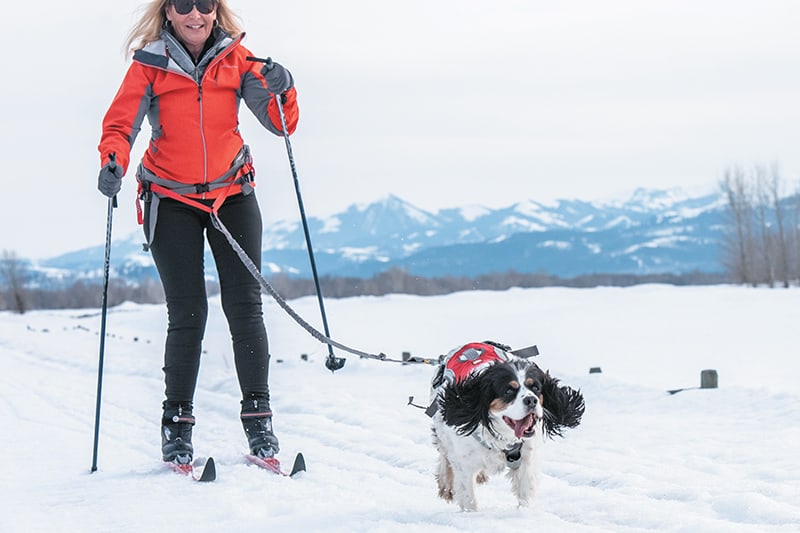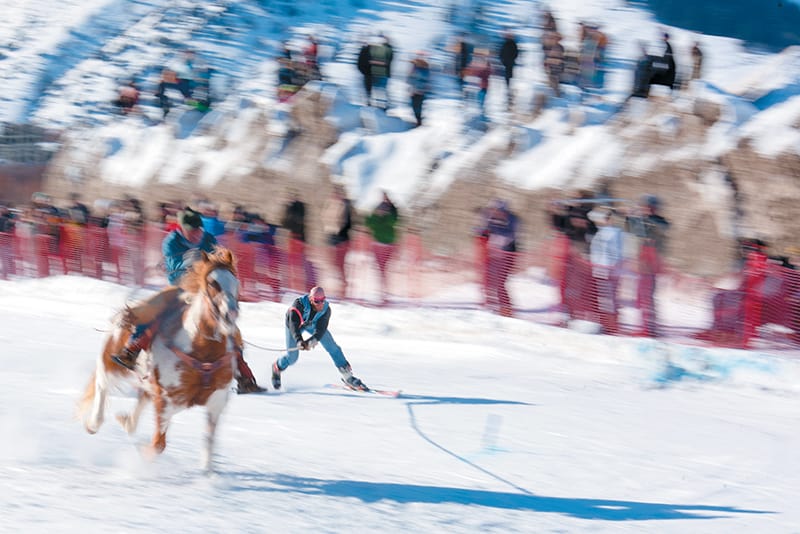Read The
Current Issue
Skijoring
Being pulled behind a dog or horse on skis is a sport. Whether it’s a serious sport or not is up to you.
By Jim Mahaffie // photography by rebecca Noble

Mayhem, a 25-pound Cavalier King Charles Spaniel mix, pulls Jane Clements near Teton Village.
THERE’S A LITTLE furry bullet in Jackson Hole that looks like she belongs on a starlet’s lap. Except this pooch prefers snow to starlets. Mayhem, a Cavalier King Charles Spaniel mix, lives to rocket around the valley’s cross-country ski trails … while pulling her owners Karl and Jane Clements on their skis.
A quick-release flexible leash is clipped onto Jane’s waist and to a chest harness on Mayhem. The 25-pound hound was raised around huskies and, like many dogs, loves to pull. “Mayhem always pulls on her leash and drives us crazy,” Karl says. “So we figured we’d put that ability to work for good and not evil.”
THIS IS REALLY A THING?
Being pulled on skis has been around as long as skiing itself. Reindeer pull skiers in Scandinavian countries, and skijoring behind horses was an event at the Nordic Games in Stockholm in 1901. Horse-style skijoring competitions were introduced in the 1928 Olympics in Switzerland. The sport first came to the U.S. (New York) in the early 1900s, then spread west. By the late 1940s it was included in the annual Steamboat Springs Winter Carnival. By the 1990s, skijoring was part of the Leadville, Colorado, Crystal Carnival and also winter carnivals in Red Lodge, Montana, and Vail, Colorado.
Skijoring has a governing body, which enforces rules and regulations for doping and sportsmanship. The North American Ski Joring Association (now Skijoring America, or SA) was founded in 1999; its first official organizational meeting was in Jackson Hole. In 2018, SA managed eight events; most were in the Northern Rockies. “We’re growing, with almost double the number of contestants in our races, and northern states from Maine to Montana are requesting we have races there,” says SA president Adam Rys-Sikora.
WHY SKIJOR?
Skijoring “isawin-win for you and your dog,” says Amy Vignaroli, who owns Teton Tails, which carries two brands of harnesses. In Jackson Hole, you can find dogs pulling skiers on groomed and packed trails and roads. Most dogjoring harnesses come with a bungee leash, so owners don’t get yanked off their skis if their dog suddenly changes direction, and a quick-release. The latter is handy when you want to detach suddenly.
Skijoring—Norwegian for “ski driving”—describes a person on skis being pulled by a horse or dog (or sometimes by a snow machine or even a car).
EQUINE VERSUS CANINE
Skijoring—Norwegian for “ski driving”—describes a person on skis being pulled by a horse or dog (or sometimes by a snow machine or even a car). While skijoring with your dog is usually a happy, relaxing outing, skijoring with horses is an entirely different ballgame: the skier holds onto a rope tied to the saddle pommel as the horse and its rider negotiate an obstacle course while racing the clock. The skier hurtles along, navigating jumps and turns, and, for extra points, grabbing and collecting strategically placed hoop rings. At the Jackson Hole Shrine Club’s annual skijoring competition, the competitors being pulled behind horses are a mix of skiers and cowboys.
Because horse skijoring is much faster than dogjoring—horses gallop at between 25 and 30 miles an hour—and because horse skijoring requires skiers to negotiate jumps and carve turns, these skijorers use alpine ski gear. Dogjorers most often use cross-country skis to avoid sharp metal edges that could injure a dog.
GETTING STARTED
“The problem is lots of dogs are taught not to pull, and switching over to skijoring is tough,” says Vignaroli. “Just about any dog can pull a skier though. It helps to have a leader ahead, human or animal, so the dog can follow. Take it slow, make it fun, and don’t have huge expectations the first few times.” Want to try skijoring with horses? The Jackson Hole Shrine Club has an amateur category in their yearly competition. But maybe you should try dogjoring first.
SPECTATING
The Jackson Hole Shrine Club traditionally hosts the valley’s major (and sometimes only) annual skijoring competition. Depending on conditions, the event, which is usually held in February, changes venues. Races have been held at the airstrip in Melody Ranch, south of the Town of Jackson, in Teton Village, and at the Teton County Fairgrounds. If you can’t catch skijoring in person, watch the 49-minute 2015 documentary, Ice Cowboys, which offers a behind-the-scenes look at the equine version of the sport in Colorado and Montana. JH
NUTS & BOLTS
Pet Place Plus (1645 Martin Ln., 307/733-5355) and Teton Tails (515 W. Broadway Ave., 307/739-9247) both carry skijoring harnesses for dogs; they range in price from $120 to $175. Easy (read: flat) trails include the Stilson Loop Trail, near the intersection of Teton Village Road and Wyoming Highway 22, and the Snake River levee by the Wilson Bridge. More difficult trails (for dogs and skiers) include Old Pass Road, Cache Creek, and Game Creek. All of these trails are free to use. The privately owned Turpin Meadow Ranch (24505 Buffalo Valley Rd, Moran, 307/543-2000; turpinmeadowranch.com) has 15 kilometers of groomed trails at varying levels of difficulty; dogs are allowed on all of them and day-use passes are $15.

Mayhem and Jane Clements

Skier Bill Allen hangs on as rider John Hyde’s horse pulls him down the track during Skijor USA’s Jackson Hole Skijoring competition at the Teton County Fairgrounds.




